A long time ago in a country far, far away, Chinese authorities managed to obtain a copy of the US’ ultimate cultural weapon, a blockbuster movie with enough special effects to wow an entire planet.
Summoned to a small theater in the southern city of Guangzhou in 1980, artist Song Feideng (宋飛等) was shown Star Wars and instructed to transform it into a traditional Chinese comic book, known as a lianhuanhua (連環畫), to promote scientific achievement.
Song was one of the first people in China to see George Lucas’ magnum opus, at a time when it was still banned — a marked contrast to the status of the series’ most recent installment in a market Hollywood increasingly sees as crucial to success.
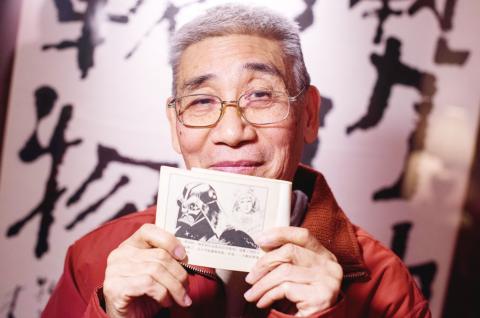
Photo: AFP
“The objective was to take the world’s advanced science and popularize it in China,” said Song, who worked for a state-owned publisher at the time.
He replaced the movie’s X-wing fighters with Soviet rockets and jet fighters. In one illustration, Luke Skywalker wears a cosmonaut’s bulky spacesuit, while rebel leaders are dressed in Western business suits. Darth Vader appears alongside a Triceratops.
At the time, China was emerging from the isolation of the Mao Zedong (毛澤東) era and Star Wars had not been granted a release by the Chinese Communist Party, (CCP) three years after it hit Western cinemas.
The movie “was very novel, very exciting,” Song said, adding that he felt as if he had seen a “glimpse of the world.”
The project came amid a brief flowering of Chinese science fiction following Mao’s decade-long Cultural Revolution, when the arts were reduced to glorifying the CCP.
Mao’s decision to send intellectuals to work in the countryside had badly affected basic scientific research.
Song spent the period on the then poverty-stricken Hainan Island, producing propaganda slide shows.
Science fiction has had a fraught history in China.
Shortly after the 1977 US release of Star Wars, the People’s Daily attacked it as a fantasy that demonstrated how Americans’ “dissatisfaction with reality” had pushed them to “seek comfort in an illusory fairyland,” but the following year, as China began to reopen to the world, Beijing declared science fiction critical to rehabilitating the nation’s sciences, releasing a flood of almost 1,000 new titles.
A translated Star Wars script appeared in China as early as March 1979, while Song’s comic is believed to be the first illustrated standalone.
It sold briskly, he recalled.
“I could buy a TV, a stereo ... it was just unimaginable,” he said.
Hwoever, the initial hopes of the nation’s “reform and opening” quickly soured as artists began to criticize the government.
Speculative stories imagining a China without communism were not the plot lines authorities were looking for and they moved to ban science fiction again.
Song’s own works — he had moved into hard-boiled noir comics featuring private eyes, femme fatales and a keen appreciation for the female form — were criticized for “spiritual pollution.”
It was not until 1985 that Star Wars first appeared on Chinese screens, at a multicity US film festival that drew millions of viewers. By the late 1980s, it was airing on local television stations, while pirate copies circulated on video.
However, the movies never developed the broad, devoted fan base they have enjoyed elsewhere and most Chinese learned of the franchise through the prequels — much maligned in the West.
Song’s comic went viral ahead of the release of the latest installment, The Force Awakens, but a midnight premiere in Beijing this month had a mostly foreign audience.
Even so the movie raked in US$90 million in its first week, according to film data Web site China Box Office.
The world’s second-largest economy is also its second-biggest movie market and Hollywood is keen to satisfy its moviegoers, who have shown a deep appetite for Western science fiction, such as Avatar or the Transformers series.
However, Beijing has shown signs of resistance to that hunger, part of a wider pushback against the influence of “foreign culture.”
In 2011, the Chinese Administration of Radio, Film and Television issued an edict discouraging movies featuring “fantasy” and “time travel,” among other “bizarre plots.”
Chinese President Xi Jinping (習近平) has instructed artists to abandon “naive sensual amusement” and instead use “true-to-life images to tell people what they should affirm and praise.”
Song has split the difference — his most recent paintings of scantily-clad models incorporate CCP-friendly themes.
An illustration of a mostly naked woman, he says, symbolizes the beauty of the South China Sea. The traditional Chinese junk boat in the background, he adds, shows that the region has been Chinese since ancient times, echoing the party line on a bitter territorial dispute.
“As long as you don’t oppose the state, don’t oppose the Chinese Communist Party, there’s no problem with whatever you draw,” he said.
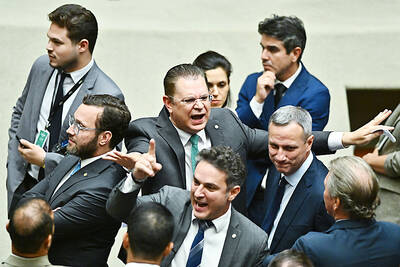
PARLIAMENT CHAOS: Police forcibly removed Brazilian Deputy Glauber Braga after he called the legislation part of a ‘coup offensive’ and occupied the speaker’s chair Brazil’s lower house of Congress early yesterday approved a bill that could slash former Brazilian president Jair Bolsonaro’s prison sentence for plotting a coup, after efforts by a lawmaker to disrupt the proceedings sparked chaos in parliament. Bolsonaro has been serving a 27-year term since last month after his conviction for a scheme to stop Brazilian President Luiz Inacio Lula da Silva from taking office after the 2022 election. Lawmakers had been discussing a bill that would significantly reduce sentences for several crimes, including attempting a coup d’etat — opening up the prospect that Bolsonaro, 70, could have his sentence cut to
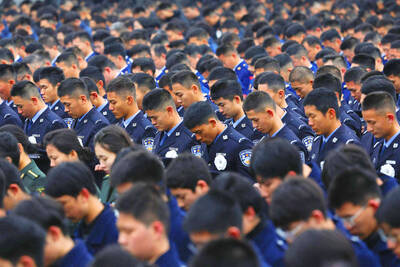
China yesterday held a low-key memorial ceremony for the 1937 Nanjing Massacre, with Chinese President Xi Jinping (習近平) not attending, despite a diplomatic crisis between Beijing and Tokyo over Taiwan. Beijing has raged at Tokyo since Japanese Prime Minister Sanae Takaichi last month said that a hypothetical Chinese attack on Taiwan could trigger a military response from Japan. China and Japan have long sparred over their painful history. China consistently reminds its people of the 1937 Nanjing Massacre, in which it says Japanese troops killed 300,000 people in what was then its capital. A post-World War II Allied tribunal put the death toll
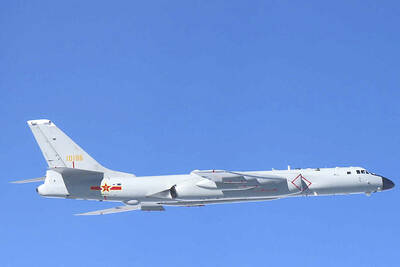
‘UNWAVERING ALLIANCE’: The US Department of State said that China’s actions during military drills with Russia were not conducive to regional peace and stability The US on Tuesday criticized China over alleged radar deployments against Japanese military aircraft during a training exercise last week, while Tokyo and Seoul yesterday scrambled jets after Chinese and Russian military aircraft conducted joint patrols near the two countries. The incidents came after Japanese Prime Minister Sanae Takaichi triggered a dispute with Beijing last month with her remarks on how Tokyo might react to a hypothetical Chinese attack on Taiwan. “China’s actions are not conducive to regional peace and stability,” a US Department of State spokesperson said late on Tuesday, referring to the radar incident. “The US-Japan alliance is stronger and more
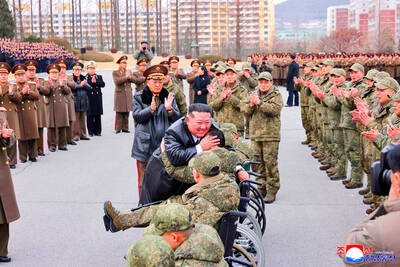
FALLEN: The nine soldiers who were killed while carrying out combat and engineering tasks in Russia were given the title of Hero of the Democratic People’s Republic of Korea North Korean leader Kim Jong-un attended a welcoming ceremony for an army engineering unit that had returned home after carrying out duties in Russia, North Korean state media KCNA reported on Saturday. In a speech carried by KCNA, Kim praised officers and soldiers of the 528th Regiment of Engineers of the Korean People’s Army (KPA) for “heroic” conduct and “mass heroism” in fulfilling orders issued by the ruling Workers’ Party of Korea during a 120-day overseas deployment. Video footage released by North Korea showed uniformed soldiers disembarking from an aircraft, Kim hugging a soldier seated in a wheelchair, and soldiers and officials